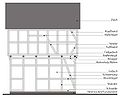Talk:Jettying
| This article is rated Start-class on Wikipedia's content assessment scale. It is of interest to the following WikiProjects: | |||||||||||||||||||||
| |||||||||||||||||||||
Article title
[edit]I've improved the title to fit with Wikipedia naming conventions, but it is not perfect. The advantage of Jettying is that verb is unique to the building use of Jetty. It is also relatively common to refer to a jettied building. However, another alternative would be Jetty (building) - 'Jetty (architecture)' could still apply to maritime Jetties. -- Solipsist 18:21, 11 Oct 2004 (UTC)
Diagram would be nice
[edit]{{reqdiagram}} The current article has two sections summarizing the horizontal and vertical elements of a jettied storey, but they're not very clear without a diagram to show where each element goes. --Quuxplusone 22:19, 3 September 2007 (UTC)
- Here are two that need a bit of English annotating:
- (If you're not up to image editing I recommend going to a WP:Graphics Lab and asking for help) --pfctdayelise (talk) 13:00, 29 July 2008 (UTC)
Jetty vs Cantilever
[edit]The term used in the section on Jettying seem to be old English briticisms. I have never before seen the terms in use in architecture or engineering while I've been studying or practicing architecture in the United States. Gary Wheeler, AIA WonderWheeler (talk) 00:46, 20 October 2008 (UTC)
- Well, yes, it is bound to be British usage. They go back to the 12th to the 16th centuries. Jetty, jettie, or jutty, and therefore the practice of building them being "jettying", is the term shown in the Oxford Dictionary of Architecture by James Stevens Curl, OUP, 1999. I don't know whether you can lay your hands on it through American libraries, but that is where you can look it up. Quite true, the definition of jetty is indeed "formed by cantilevered floor-joints", but the keyword is "jetty", etc. Yes, if you were to build a house in that style during the present time you would probably call it "cantilevered".
- By the same token would you have heard of "bressummer" or "breastsummer" for the wall that either projects from the wall below, or the wall below that supports the wall above in these ancient houses? You will have seen a few of these in Stratford-upon-Avon, Shakespeare's town. Dieter Simon (talk) 23:20, 20 October 2008 (UTC)
jettying in plain style of lisbon
[edit]em ressalto, in portuguese, can be about the main facade but also about each story, that thus uses public space away from circulation, while giving room for a landing to longer stairs and private area too, on the inside close to facade, in plain architecture that is, since medieval revivals can add it to some rooms for style recognition — Preceding unsigned comment added by Deslize (talk • contribs) 13:39, 1 May 2013 (UTC)
"They are considered a Gothic style..."
[edit]Are they? I wouldn't have thought so. Given, they date back to the same general era as Gothic churches; but there, surely, any resemblance ends. Nuttyskin (talk) 00:25, 27 October 2022 (UTC)
Taxes? Is this true?
[edit]I heard somewhere that the main reason they did this at some point, in some nation, was because houses were taxed based on the square footage of the ground floor, thus making it possible to save BIG BUX!!! by having a smaller footprint. I see no mention of this in the article and can't find anything about it online. Is this just total dreck? jp×g🗯️ 07:38, 30 October 2023 (UTC)



